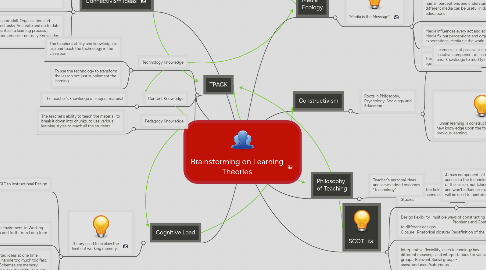
1. Connectivism Ideas
1.1. Increased ability to "do something", Connecting specialized nodes, Integration of Cognitive and Emotion, Non-human Applioances
1.1.1. Sub Idea 1
1.1.2. Sub Idea 2
1.2. Practical competence, Learning rests in a community, nest or database
1.3. Knowing where to find is more important than knowing information, Nurturing and maintaining connections, Diversity of options, Courses are not primary conduit for learning
1.4. Ability to see connections is a core skill, Organization and personal learning are integrated tasks, Accurate and up to date knowledge, Decision-making is itself a learning process, Learning is a knowledge creation process- not only Knowledge consumption
2. Cognitive Load
2.1. Theory used to explain the limits of working memory.
2.1.1. Applications of CLT to Instructional Design
2.1.1.1. Knowledge compression (chunking)- Working memory is more effective when broken into meaningful chunke, receiving data with graphic organizers, job aides and mneumonic devices
2.1.1.2. Repetition- isolated and reherarsed multiple times, Comprehension benifits from knowledge. Unclogging Cognitive traffic jams with "info landscapes"- Provide meaningful info contexts or landscapes, Clear and elegant design principles
2.1.2. Data coming from enviroment to Working Memory and back and forth from Long term Memory
2.1.3. Working momory can handle 7 disconnected ideas at one time, Overload is when working memory has to handle too much too fast, Long term memory is virtually unlimited, Schemas are memory structures, Working memory is overloaded when it's ability to build schema is compromised
2.1.4. If working memory has capacity left over it can access info from long term memory, Automation (doing something without concious thought) comes from having well developed schema.
3. TPACK
3.1. Technology Knowledge
3.1.1. The teacher's ability and knowledge to use and teach the technology in the classroom
3.1.2. To use the technology to transform the lesson not just supplement the learning
3.2. Content Knowledge
3.2.1. The teacher's knowledge of subject material
3.3. Pedagogy Knowledge
3.3.1. The teacher's ability to teach the material, to break it down into chunks, to use various learning styles to reach all the students
4. SCOT
4.1. Theory within the field of Science and Technology Studies
4.1.1. Argues that technology does not determine human action, but rather human action shapes technology.
4.2. Design flexibility- multiple ways of constructing technologies Problems and Conflicts- leads to different designs Closure- Rhetorical closure/ Redefinition of the problem
4.3. Interperative flexibility, each technology has different meanings and interpertations for various groups, Relevant Social groups- uses/producers/subgroups
5. Media Ecology
5.1. "Media is the Message"
5.1.1. Media acts as extensions of the human sense in any era
5.1.1.1. Hot media refers to high definition communication that demand little involvement from audiences.
5.1.1.2. Cool media describes media that demands active involvement from audiences.
5.1.2. How media and communication processes affect human perceptions and understanding, The idea that different media can be useful in different areas of educations
5.1.3. Media influences every act and action in society, Media fix our perceptions and organize our expectations, Media tie the world together
5.1.4. Tribal age/ Literary age/ Print age/ Electronic age
6. Constructivism
6.1. Roots in Philosophy, Psychology, Sociology and Education
6.1.1. Learners is not passive, instead reception is anactive compenent of learning, Learners use prior knowledge to modify new knowledge
6.1.1.1. Sub Idea 1
6.1.1.2. Sub Idea 2
6.1.2. Human learning is constructed, learners build new knowledge upon the foundations of previous learning
6.1.2.1. Learners have to re-evaluate previous learnings to accomodate new experiences, Apply current understandings/ note relevant elements/ judge constincey of prior and emerging knowledge based on judgement they can modify knowledge
6.1.2.2. Emphasizes authentic challenging projects, Learners assume responsibility of their own learning, Develop MetaCognitive abilities to monitor and direct their own performance
6.1.2.3. Collatorative working is a focus, Generate meanings and solutions through shared understanding
7. Philosophy of Teaching
7.1. Teacher's personal ideas and views added becomes "Teachology"
7.1.1. 4 main components of this philosophy 1) Accessibility- to ensure all students have access to the technology 2) Alighnment- the technology is in keeping with the line of the lesson, not taking over teaching 3) Assesment- cirriculam based assesment and won't influence students assement negativley 4) Reinforcement- technology will be used to reinforce the lesson and other methods will also be incorporated.
